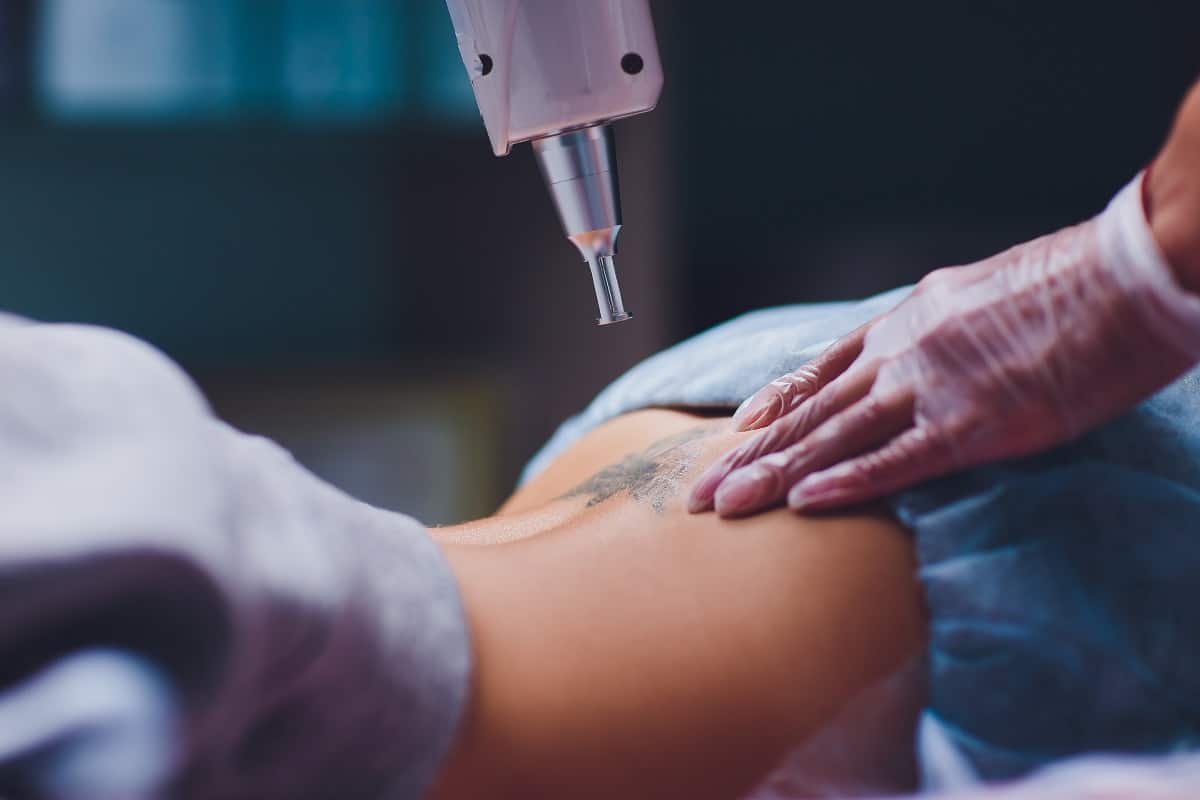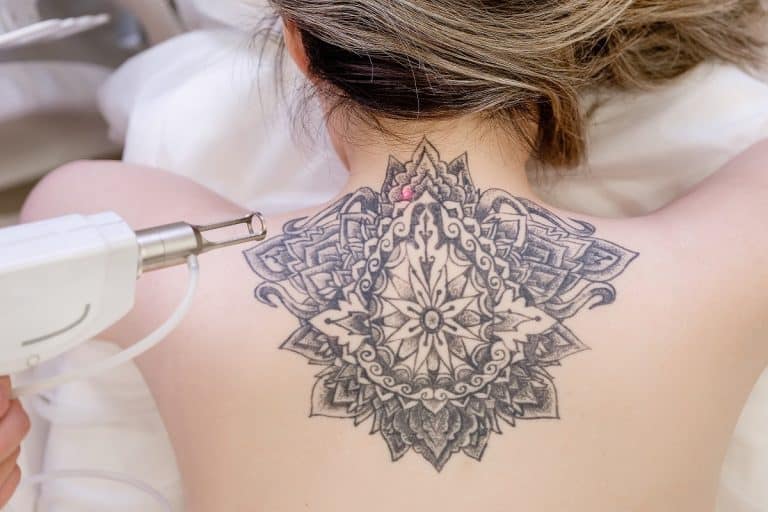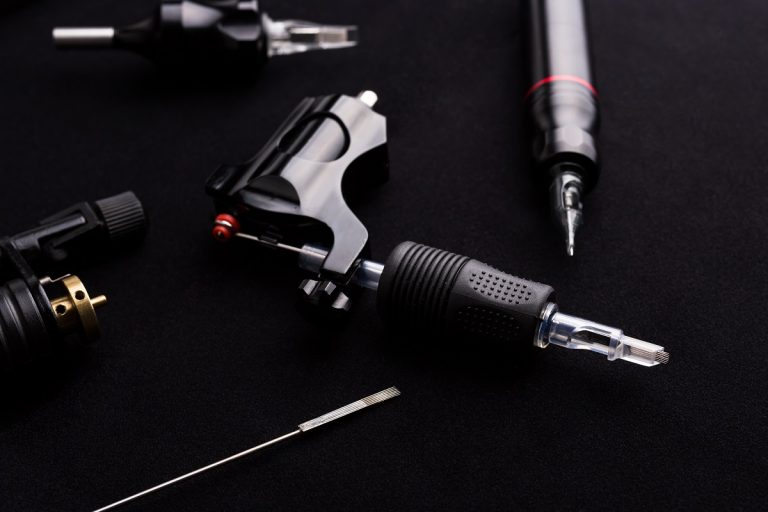Laser Tattoo Removal Before and After: Ultimate Guide 2024
Whether that tattoo just doesn’t look great anymore, or it brings up bad memories, getting it removed will be on your mind. And there’s nothing wrong with that. You should feel happy with your body – whether that means adding tattoos or removing them.
So, how exactly do you go about getting tattoo removal? Well, we’ve created this guide so you can find out. From legitimate tattoo removal methods to common questions and concerns.
Let’s cut to the chase, starting with the most popular way to remove a tattoo: laser tattoo removal.
Laser Tattoo Removal: Your Best Option
Laser tattoo removal is the process of firing lasers at your skin to remove a tattoo. But don’t freak out – there aren’t any James Bond villain lasers coming your way and you don’t need to be strapped down to a table either.
In fact, the laser tattoo removal is comparable to IPL (intense pulsed light) hair removal treatment, and other laser hair removal methods.
You just book a session at a clinic that offers laser tattoo removal and show up for your appointment. No major surgery necessary (although surgery is an option for removing tattoos – see below).
How Do the Lasers Work?
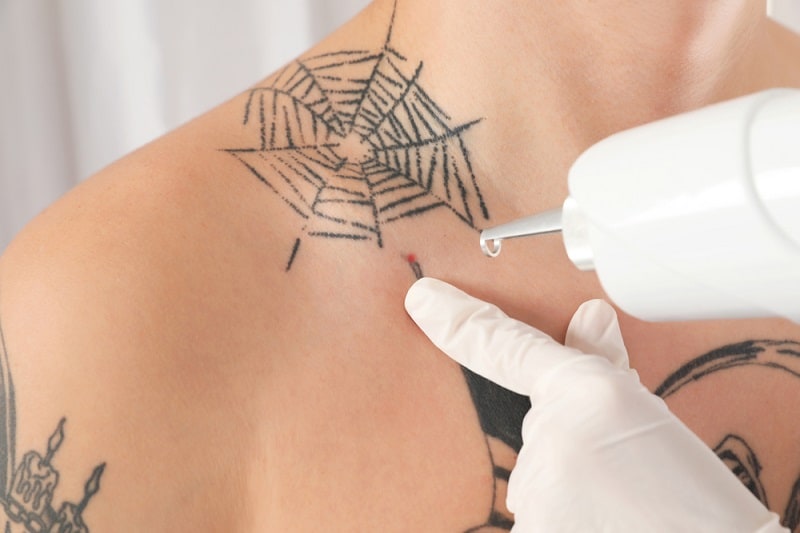
The lasers penetrate your skin to the dermis layer, which is where the tattoo ink was deposited. But don’t worry – unlike tattoo needles, the laser doesn’t actually penetrate your skin.
Instead, the laser fires natural infrared light at different wavelengths. The ink absorbs the light and breaks down from a semi-solid state to a solid state. Basically, the light turns the ink from large, permanent particles to smaller and smaller particles.
Once the ink has fractured into very small particles, your immune system can get to work. Your body will naturally try to flush out the ‘foreign’ ink particles that were too large to tackle before. Macrophages (special white blood cells that work for the immune system) slowly remove the ink via your blood.
It sounds a bit scary, but laser tattoo removal is completely safe. It’s actually the recommended method of tattoo removal by the FDA, and a lot of laser tattoo removal equipment is checked and approved by the FDA too.
Wavelengths
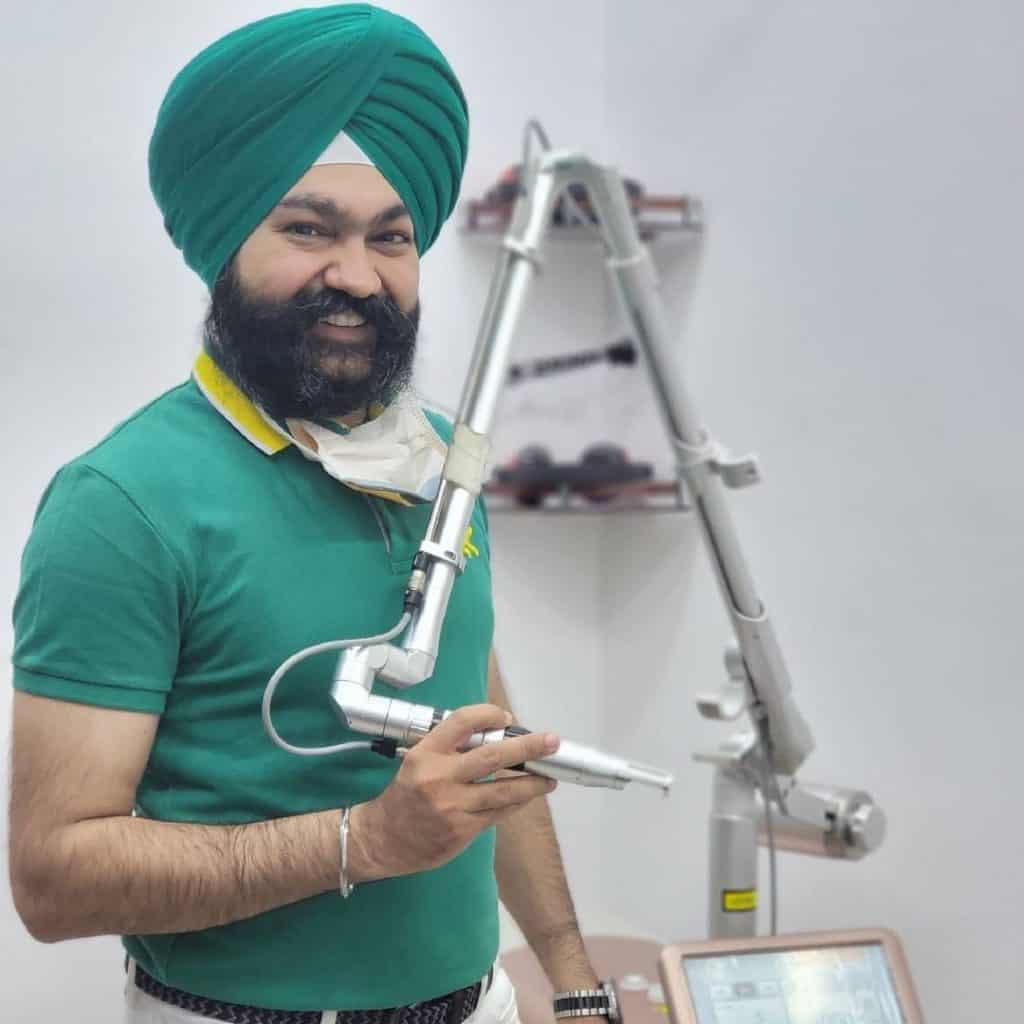
The wavelengths needed depend on the color of the ink. Some colors absorb more light and break down easier, while other colors are more stubborn.
- 1064nm – dark inks, including black and blue. The most effective wavelength.
- 532nm – bright and warm colors, including red and orange. Effective for these colors only.
- 694nm – very bright blues and greens. This wavelength isn’t commonly used.
Generally, dark inks and black lines are easiest to remove. Dark colors absorb light effectively. Lighter colors and particularly ‘sunset’ colors are harder to remove.
But either way, you can completely remove a tattoo with the laser method. Some tatts will just require more sessions than others.
What Does Tattoo Removal Cost?
The cost varies. It depends on the person offering the service – a fashionable health clinic in Beverly Hills is going to cost more, obviously.
But it also depends on your tattoo.
The more sessions you need, the more it will cost. Generally, it’s in-line with the cost of getting the tattoo in the first place. For example, a tiny black outline of a heart on your thumb didn’t cost much to get inked, and it won’t cost much to get removed, as there’s just one color and it’s a tiny design.
On the other hand, a large sleeve with every color of the rainbow will take much longer to remove, utilizing many sessions and various wavelengths to effectively remove all of it.
In general, a tattoo removal session costs between $500 and $1000. You could need one or two sessions, but the largest and most colorful tattoos can take up to 20. So, your max spend should be around $20,000.
You can read more about tattoo removal costs, as well as who should and who shouldn’t get laser tattoo remove, in this guide.
What is Tattoo Removal Pain Like?
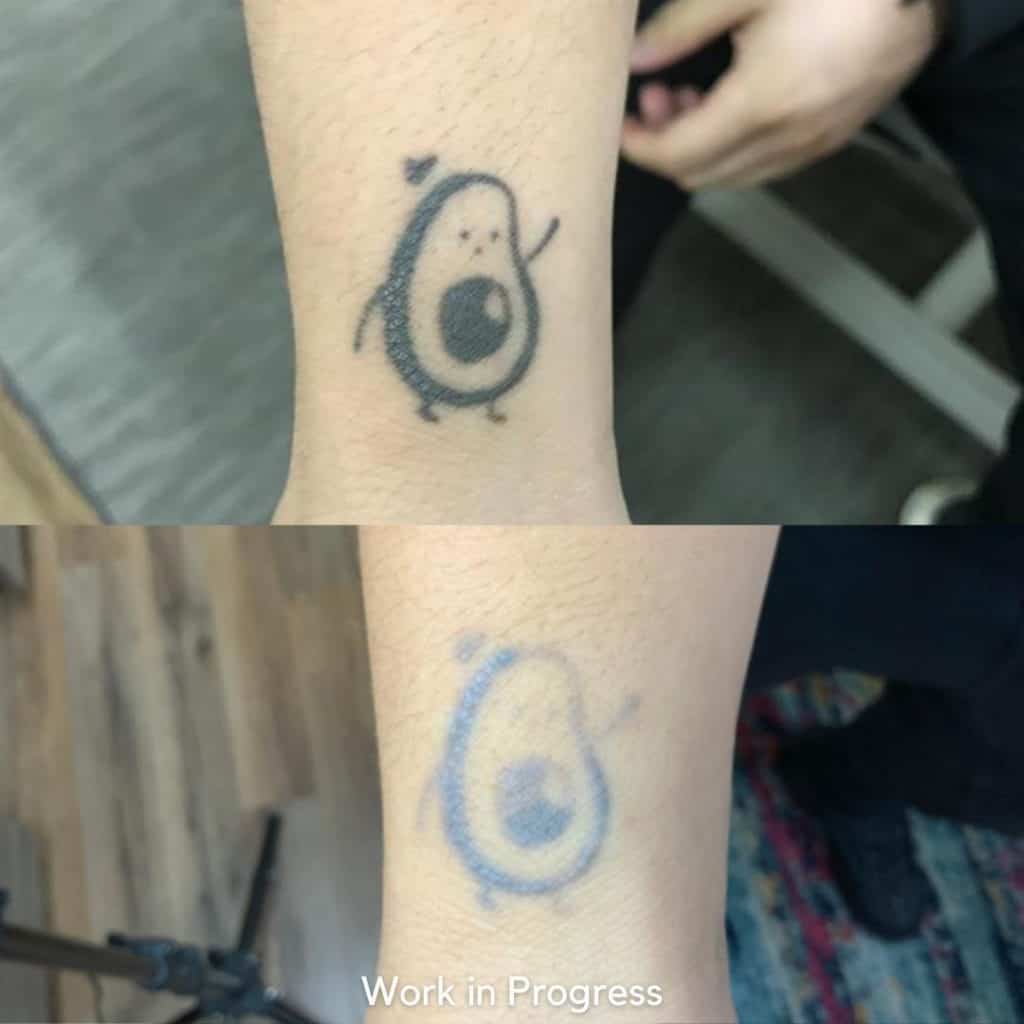
The laser gun fires short pulses of light – this is important. The short pulse of intense light will break down the ink but won’t damage the surrounding skin cells.
That means that the overall process isn’t that painful. The light bursts aren’t long enough to cause any serious damage and pain… but that doesn’t mean it won’t hurt.
Getting a tattoo removed is comparable to applying friction on sunburn. So that’s good news. If you were brave enough to get a tattoo, you’re certainly brave enough to get it removed. It is uncomfortable, but it’s not as painful as getting the tatt in the first place and it’s a lot quicker. Most sessions only take a few minutes.
Many clinics will apply a numbing cream beforehand as well, to reduce the pain further.
Tattoo Removal Before and After
Yes, you can actually see it working like that! There are plenty of videos online showing you tattoos being removed via laser – it isn’t a big secret in the industry at all. In fact, if a tattoo removal specialist doesn’t tell or show you the equipment they use and how it works, that’s a bad sign. They should always be upfront.
In this picture, you can see how the tattoo fades over multiple sessions. This tattoo was comprised of very thick and heavy black lines, which are actually one of the easiest and quickest colors to remove. After four sessions, you can see that the tattoo is really fading away.
This highlights the importance of multiple sessions. If you can only pay for one or two sessions, you’ll likely be unsatisfied with the results. You need to commit!
https://www.instagram.com/p/COcKA7UnJj0/
Tattoo Removal Aftercare Tips
Although laser tattoo removal is non-invasive, there are sometimes side effects. Redness, swelling, and discomfort are pretty common (again, like a sunburn) but you may also have some light scabs or blisters that form.
Thankfully, scarring from laser tattoo removal is almost unheard of nowadays. Laser technology has evolved a lot, so you don’t need to worry about any permanent scars once the tattoo is removed. If you are concerned about scarring at all, check with the clinic or professional doing the tattoo removal. Find out what laser they use and do some research – if it’s a modern laser, you have nothing to worry about.
Once your tattoo removal session is over, you can follow these steps for aftercare.
- Days 1 to 3 – keep the area sterilized with antibiotic ointments and covered with medical gauze.
- Days 3 to 7 – remove the gauze and keep the area clean and dry. Don’t soak the area – instead gently dampen it and clean with mild soap. Pat dry.
- Days 7+ – continue to keep the area clean and dry. Don’t soak it in water until it has completely healed. Ointments with vitamin E can help the healing process.
Throughout the healing process, you shouldn’t expose the area to the sun. UV rays are not good for your skin as it heals. So, cover up the area with gauze and bandages when you go outside, and once you’ve passed the first week, you can apply sunscreen protection instead.
Once your skin has healed completely, it’s time for another session under the laser.
Bear in mind that the healing time depends not only on the size of the tattoo and ink colors, but your immune system too. Some people heal faster than others.
Read More: Laser Tattoo Removal Aftercare Instructions (5 General Instructions And 7 Equally Important Tips)
DIY Laser Tattoo Removal
With laser tattoo removal sessions costing so much, it’s understandable that so many people are looking to remove their tattoos at home. So, this is where the DIY laser tattoo removal industry steps in.
There are a few options out there, from buying your own laser removal machine to trying some of the creams and ointments available (more on why you should NOT use these below).
There are some important things to note:
- Most professional lasers can only be bought by certified professionals,
- You need to take safety seriously – that means wearing eye protection, reading the manual, etc.
- Never buy any device, cream, lotion, or any other product that claims to remove tattoos unless it has been checked and approved by the FDA.
In general, it is always best to pay for a professional to remove your tattoo. They know what they’re doing. and you are guaranteed a great result. It’s worth saving up for!
Oh, and if you are yet to get your tattoo, but are worried about the costs of removing it if you dislike it, keep scrolling. We have a section on temporary tattoos below that you’ll find very interesting.
How to Buy a Laser Tattoo Removal Machine
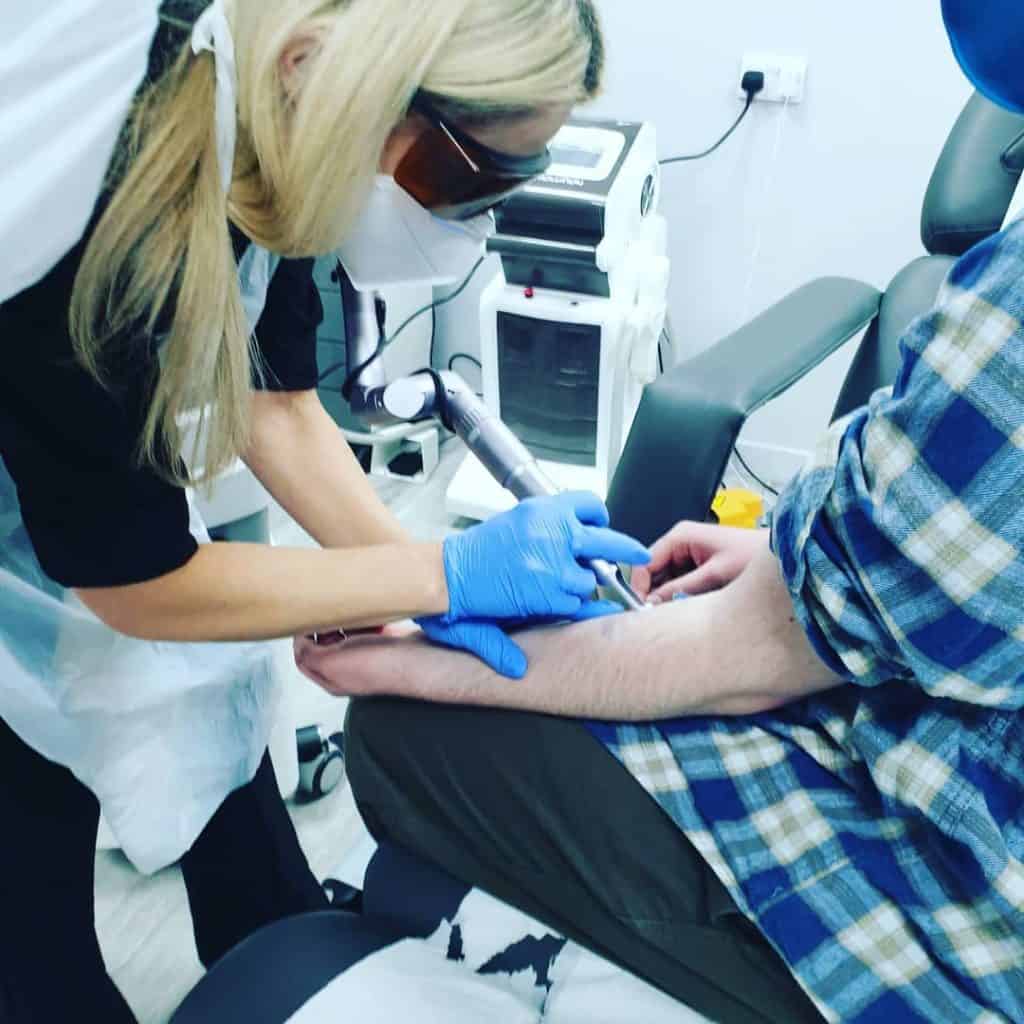
Here is your check list of things to consider when you look to buy a laser tattoo removal machine:
- It’s been tested and approved by the FDA,
- It has real reviews from customers who’ve used it,
- It is made from removing tattoos, not other cosmetic purposes,
- Has a high level of energy (j/cm2 or mj),
- Has an appropriate spot size – the right size for your tattoo.
You’ll also want to look for the standard things you should always look for – a reputable seller, a decent returns policy, product warranty, etc.
All laser tattoo removal machines boil down to two types:
Q-switched Nd: YAG lasers – the older type, but still effective. They often have limited wavelengths, so check that it has the right settings for your tattoo colors.
Picosecond lasers – the modern type that’s generally more powerful and effective than Q-switched… but of course, that also makes them way more expensive.
And finally, the cost. We know that’s going to be the biggest buying factor for you. Our list of the best laser tattoo removal machines shows that they can range anywhere from $100 to $100,000.
Most tattoo laser machines are made for repeated use in clinics, which is why they cost so much. But you’ll only be using it for a handful of sessions. That’s why it can often work out cheaper to book sessions with a professional tattoo remover.
Why You SHOULDN’T Use Tattoo Removal Cream
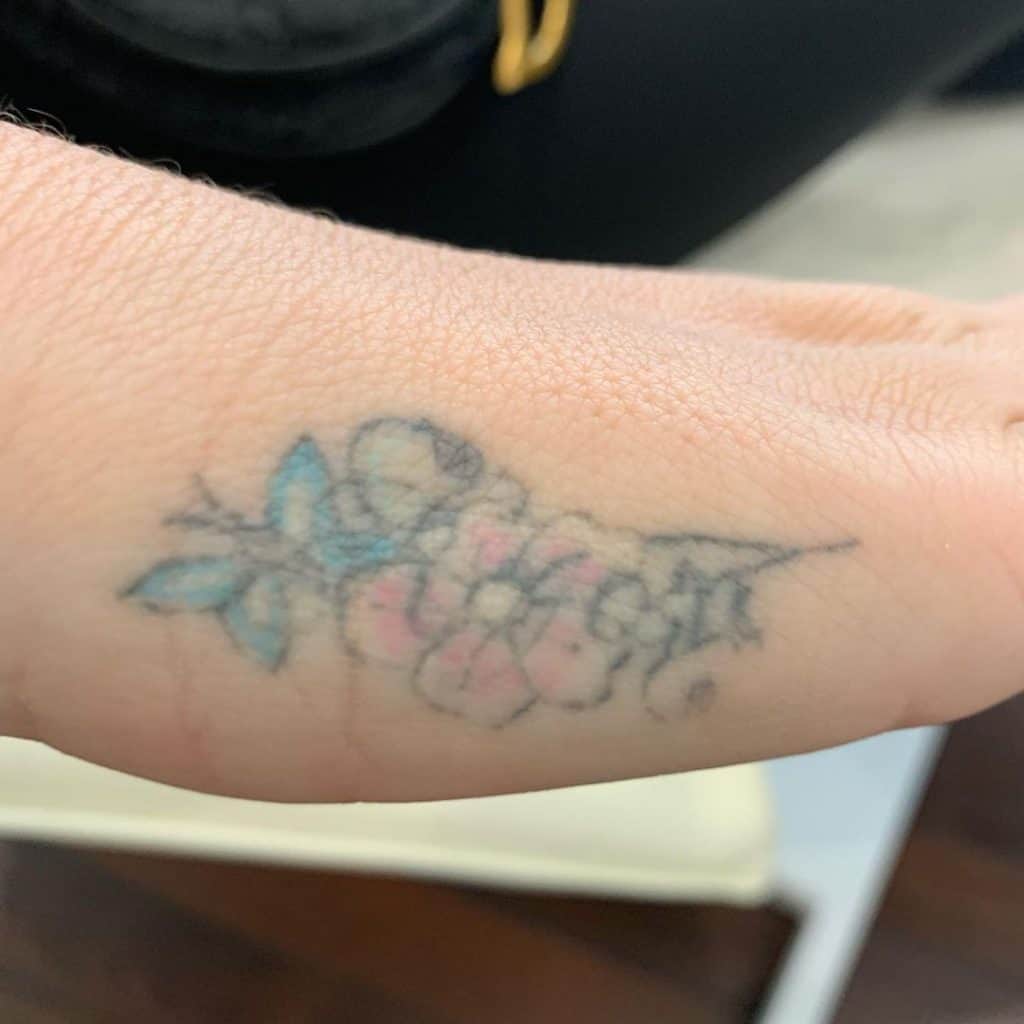
Just don’t do it.
No, seriously. Don’t do it.
Tattoo removal creams are ineffective and at worst, dangerous. They can damage your skin, leave permanent scarring, and there’s no guarantee that they’ll even remove your tattoo.
If you don’t believe us, just ask the FDA. They state that there’s no clinical evidence that they work and they haven’t approved any DIY creams/ointments at all.
“tattoo removal ointments and creams may cause unexpected reactions, such as rashes, burning, scarring, or changes in skin pigmentation in the process”
So, don’t be tempted by these products. They may be cheap, but they’ll still be a waste of your money. Worryingly, they’re widely available on Amazon and elsewhere online. But don’t be tempted to try them and make sure you spread the word to other people considering them!
You can always report any dangerous products, concerns, or noticed side effects to the FDA. They will investigate, warn other consumers, or may even get the product removed completely.
Read More: Do Tattoo Removal Creams Work? Here’s Everything You Need To Know
And Why Natural Tattoo Removal is EVEN WORSE!
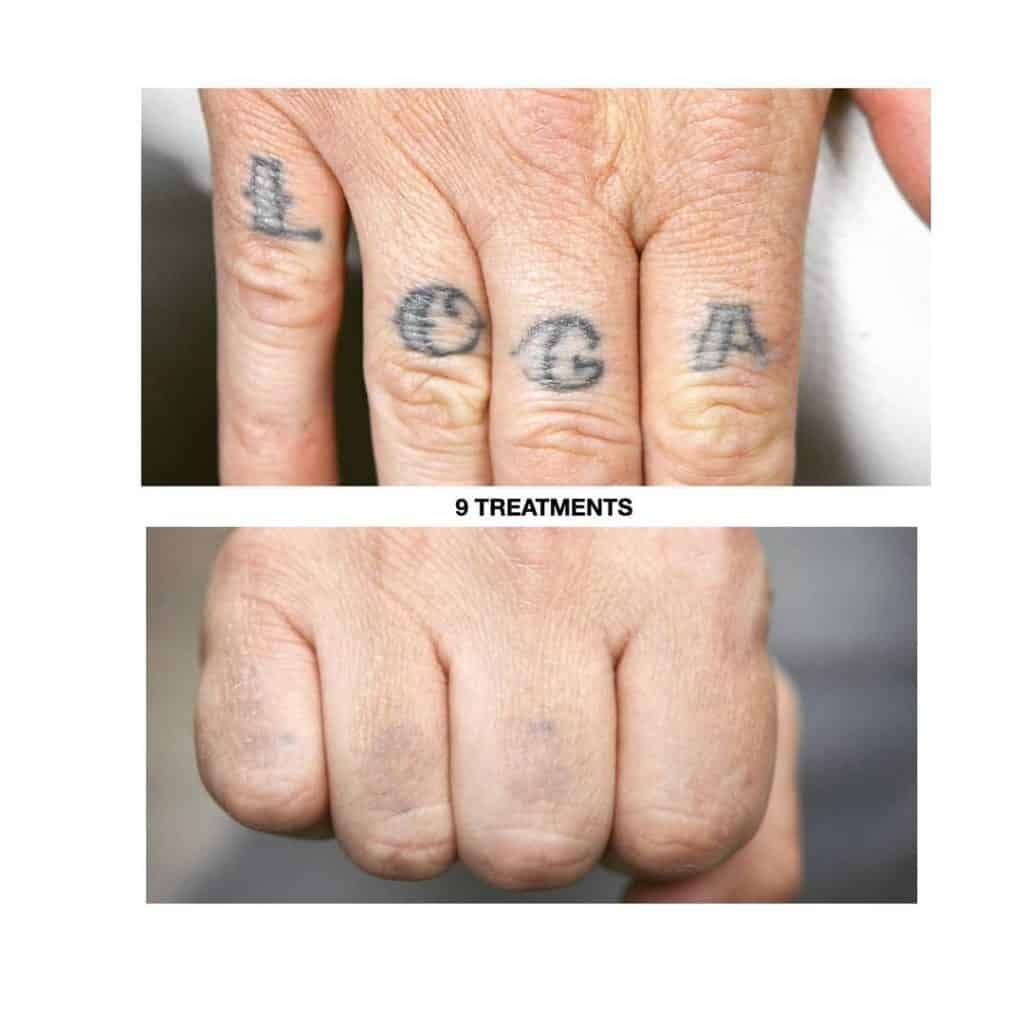
If you thought tattoo removal cream was bad, these “natural” methods of tattoo removal are even worse. Here are some of the most dangerous (and painful) ways to try to remove a tattoo:
- Sandpaper – extremely painful and won’t effectively remove the ink. You can’t sand down to the dermis layer of your skin without bleeding everywhere and causing a lot of pain.
- Aloe vera – this lovely ingredient soothes inflammation and will feel great on your skin. But it has no impact on your tattoo whatsoever. This is a waste of time!
- Salabrasion – it’s like the sandpaper method but using salt instead. It’s ineffective, highly painful, and will lead to an infection. Oh, and you’ll still have a tattoo at the end of it.
- Lemon juice – not only will it do nothing for your tattoo, but it will irritate your skin. If you go overboard with the lemon juice, it can even cause blistering and swelling when exposed to sunlight.
All these methods are silly or downright dangerous. You’re going to see a lot of people recommending them online but take it from someone who has had a tattoo removed – laser is the only way to go.
Read our article ‘Can a Tattoo be Removed Naturally?’ for more information on what to do (and what to avoid).
Also Read: Removing a Tattoo With Salt: Does It Work?
Other Tattoo Removal Options
So far, we’ve been really focusing on laser tattoo removal because it’s the best! There’s no denying that. But there are also two more options on the table when you have a tattoo you no longer like. These are surgical tattoo removal and getting even more ink!
Surgical Tattoo Removal
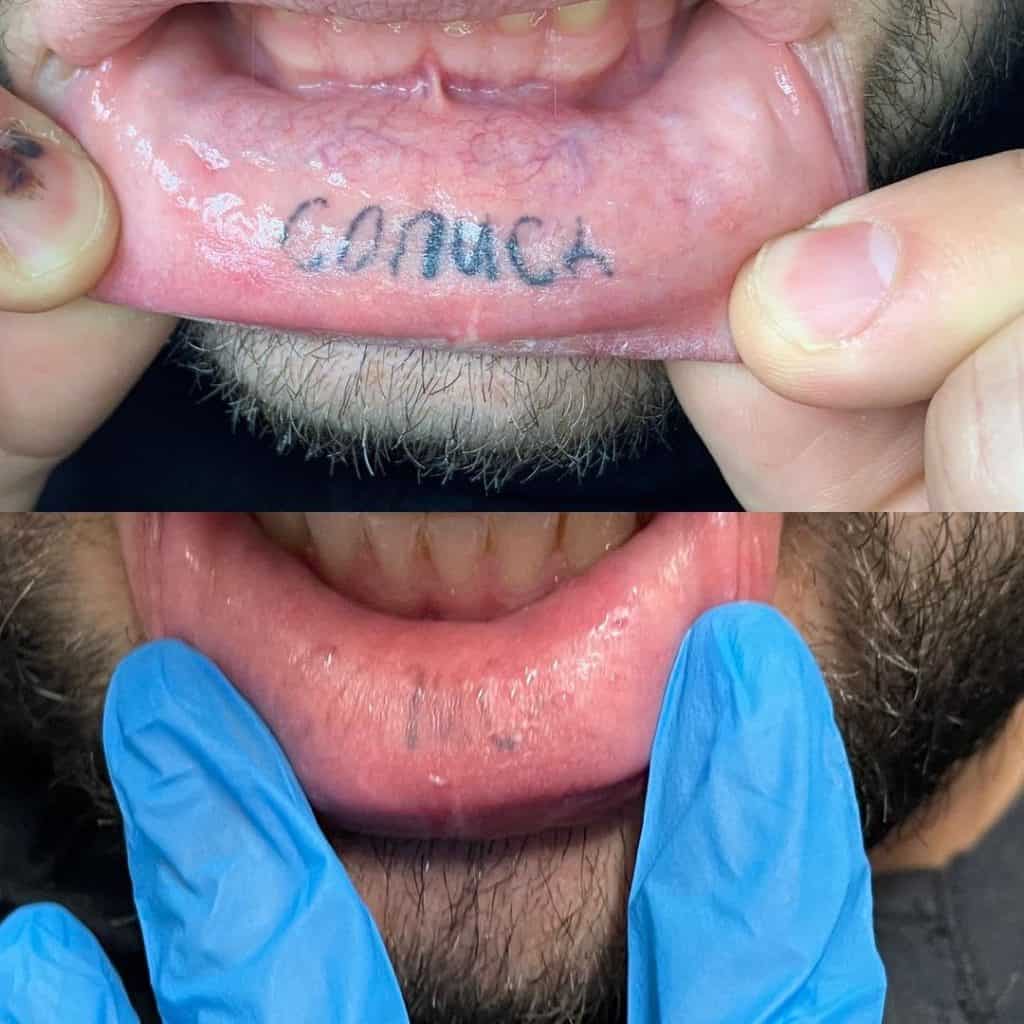
While laser tattoo removal is best, there are still some circumstances where surgical removal is a better option.
- You need a tattoo removed instantly, not over several sessions,
- Your tattoo contains ink colors that aren’t easily removed by laser,
- Your skin reacts badly to laser treatment,
- You don’t want the pain and discomfort associated with laser tattoo removal.
Getting surgery might seem extreme, but it’s actually quicker and easier than laser tattoo removal. The procedure is done with local anesthetic, which means the tattoo area is numb (you won’t feel any pain) but you’re still conscious throughout the surgery.
For most small and medium tattoos, the surgery can be done in the morning and you’ll be back home by the afternoon. Once it’s done, it’s done.
The surgery to remove the tattoo actually removes layers of your skin. Once the inked skin is removed, the surrounding skin is stretched over and stitched together. Another option is to get a skin graft on the area. Either option will leave a scar, but every trace of the ink will be removed.
If your tatt is on a really boney area of your body, you might not be able to get the surgery.
Cover-Up Tattoos
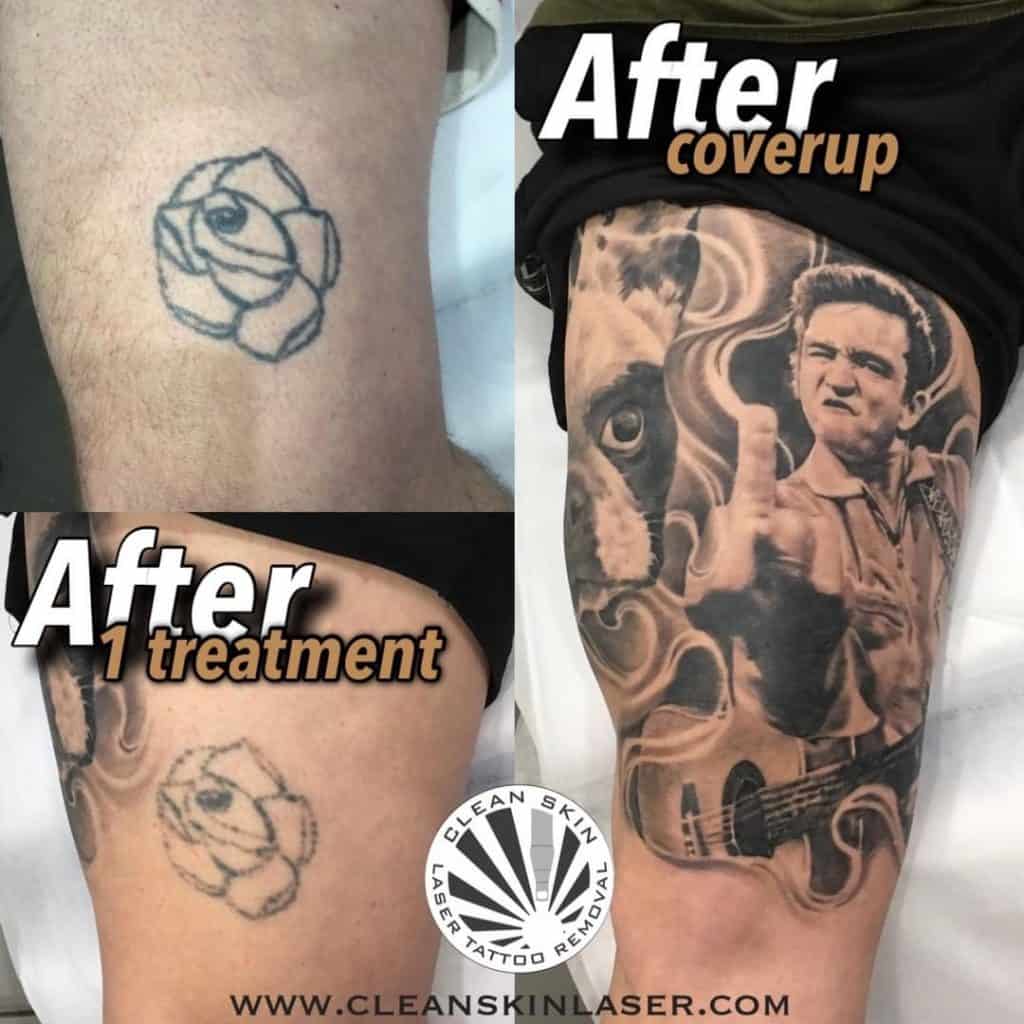
Don’t like your ink? Maybe you could cover it up. But not with makeup, with more ink. Head back to your favorite tattoo artist and come up with a new design to cover the old.
This is difficult with large tattoos, but not impossible. It works best for small and medium sized tatts. You’ll also need your new tattoo to be bold, dark or colorful to make sure it hides the ink.
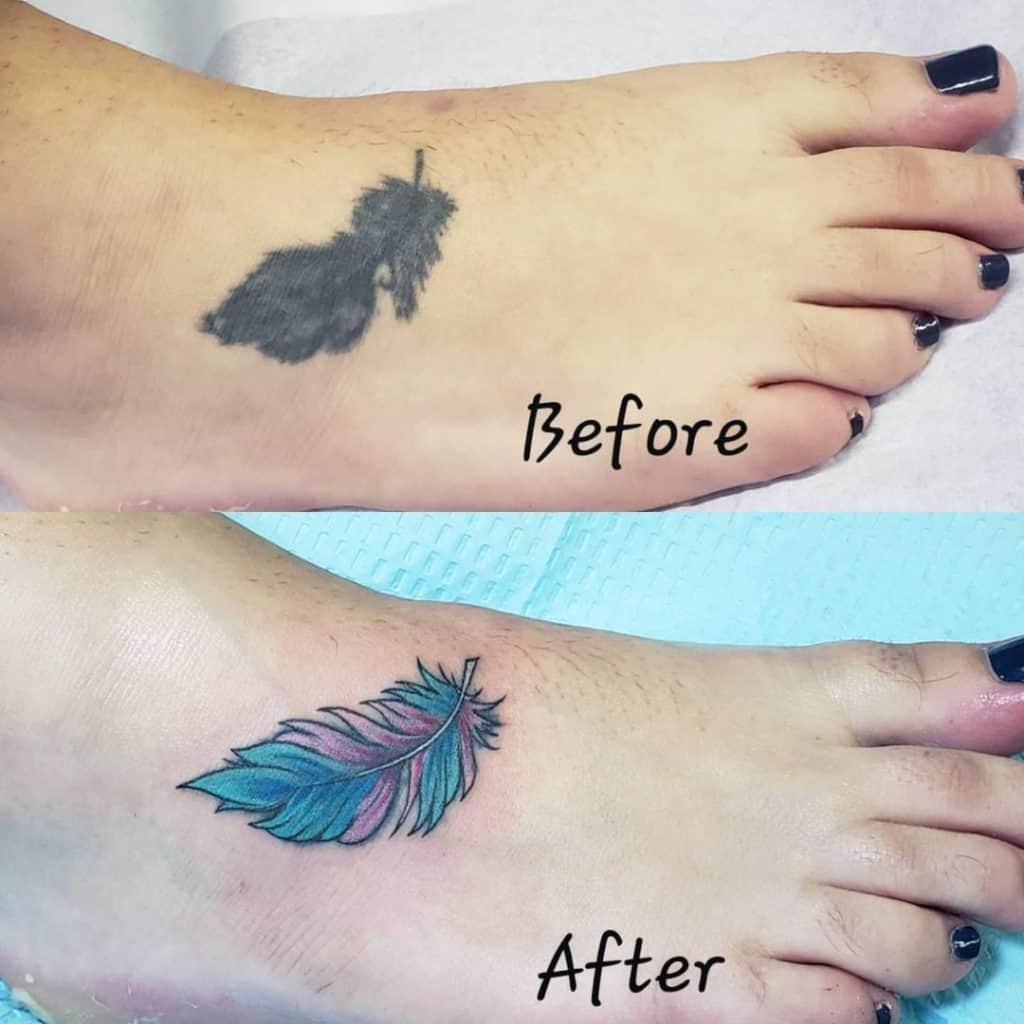
Some tattoo artists can be very clever with creating designs that warp or ‘correct’ the tattoo rather than covering it completely. You might need to do a little extra research to find a tattoo artist capable of this, however.
As for the cost of covering up a tattoo, it’s the same as getting a tattoo in the first place. Read our ultimate guide to tattoos to learn more about tattoo costs.
Also Read:
5 Weirdly Interesting Facts About Removing Tattoos
We bet you didn’t know these facts about tattoo removal!
1. How the Ancients Removed Tattoos
Just like the art of tattoos goes back centuries, so does the task of removing them. The most common way of removing tattoos used to be burning them off! Applying a white-hot iron to your skin leaves a horrible scar… but it does effectively remove the tattoo.
During the early 20th century, acid was used instead. We’re so glad this is no longer common practice!
2. Tattoo Removal is Growing
The demand for tattoo removal is growing. According to Compare Camp, services for the removal of tattoos has increased in demand by 32% and experts predict that it will continue to increase.
That doesn’t necessarily mean that more people want their tattoos removed than usual! It could be thanks to the advances made in laser removal, which makes it possible to remove tattoos effectively without scarring.
3. Celebrities Get Tattoos Removed Too
According to Inked Mag, quite a few celebrities have had their tattoos removed.
- Angelina Jolie – removed a tattoo of her ex’s name. We can relate to that! She now has another tattoo over that placement.
- Megan Fox – removed a Marilyn Monroe portrait from her arm. Why she did this, we aren’t sure. We quite liked it!
- Johnny Depp – removed “na” from his “Winona Forever” tattoo, so it reads “Wino Forever”. A good example of how partial tattoo removal or covering up ink with new ink, can be a good solution.
4. 8 to 10 Laser Sessions is Average
How many tattoo sessions you need depends on your ink, tattoo size and the efficiency of the laser model. If you Google what the average number of sessions is, you’ll get a lot of different results.
We’d say the average is around 8 to 10 sessions for complete removal. So, be patient! If you are worried about the cost of tattoo removal sessions, talk to the clinic about spreading the payments into affordable monthly payments.
5. Darker Skin Tones
Dark tattoos on pale skin are the easiest to remove by laser. Darker skin tones are more likely to experience burns, scars and even hypopigmentation.
The pigments contained in darker skin tones are similar to pigments of the tattoo ink, so the laser can cause hypopigmentation (where your skin is lightened as well as the tattoo). To combat this, shorter tattoo sessions at a gentler light wavelength can be used… but that does mean the entire process is stretched out even further.
This article by a laser clinic explains the science behind it in more detail. If you have a darker skin tone, there are still plenty of options available for you. A professional and experienced laser tattoo remover will be able to remove your tatt effectively regardless.
Scared of Pain? Skip Traditional Tattoos

If you’ve been reading this guide because you want to prepare for the worst, we applaud you! You are very wise for checking out what tattoo removal is like before you get your first tatt.
And, if you’re feeling a little queasy about needles and lasers, you might want to consider temporary tattoos instead.
A temporary tattoo:
- Professional way to apply a temporary tattoo (not those silly kid’s tattoos),
- Applied using water, ink and paper,
- Can last for weeks,
- Easy to remove!
We highly recommend checking out temporary tattoos. Some companies have catalogues of over thousands of designs, and you might even be able to design your own.
If you decide you don’t like the temporary tattoo, you can remove it easily using our methods to remove temporary tattoos. Simple household ingredients from coconut oil to sugar scrubs are all you need.
Also Read:
Tattoo Removal: More FAQs
Too busy to read our full guide? No problem, we understand! Here are the top questions we are asked about tattoo removal, and short answers to each. You can always leave a comment to ask any questions that we’ve missed.
Can lasers completely remove tattoos?
Yes, they can. It may take several sessions and cost quite a bit of money, but a good laser tattoo removal service leaves no trace of the original tattoo.
How much does laser tattoo removal cost?
One session can cost anywhere from $500 to $1000. It depends on the size of the tatt and other factors – read our section above on tattoo price to learn more.
Is it worth getting laser tattoo removal?
Yes, it is worth getting laser tattoo removal if you want a tattoo removed completely. But it’s only worth it if you pay for (and attend) all sessions. It may take several to remove the tattoo entirely.
How painful is laser tattoo removal?
It’s uncomfortable. While getting a tattoo has a sharp pricking sensation, laser tattoo removal is more like applying friction to bad sunburn. It’s not pleasant, but it’s not necessarily ‘painful.’
What is the best way to remove a permanent tattoo?
Laser tattoo removal is the best and most effective way to remove a permanent tattoo. It takes several sessions, but the finished result is amazing. You can remove every trace of ink.
Can I remove a tattoo at home?
Yes, if you have a professional laser tattoo removal machine. Tattoo removal creams are dangerous – don’t use them at home. Most often, you’ll need to visit a clinic to have the tattoo removed.
Does tattoo removal leave scars?
No, laser tattoo removal and even surgical tattoo removal won’t leave scars. If you use an unregulated dangerous laser, or try a “tattoo removal cream” you might experience pigmentation and skin damage.
- Safe, non-toxic plant-based temporary tattoos made with 100% high-definition printing for a realistic look without the pain
- Easy to apply and remove - just stick for 20 seconds then take off
- Set includes 5 sheets with 17 fun, delicate designs like hearts, cats, smiles, suns, moons, and more
- Waterproof and long-lasting - stays on up to 2 weeks of wear
- Fashionable for women, men, girls and boys
- Place on arm, wrist, neck, leg, finger, waist, foot and more
- Great for parties, birthdays, and showing your unique style

